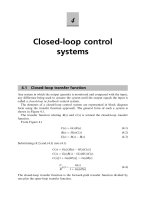Lecture Requirement engineering Chapter 4 Requirement analysis
Bạn đang xem bản rút gọn của tài liệu. Xem và tải ngay bản đầy đủ của tài liệu tại đây (2.18 MB, 46 trang )
DFD
definition
DFD components
DFD Key definition
DFD level
Data
flow diagram shows business processes
and the data that flows between them.
Data flow modeling takes a functional
decomposition approach to systems analysis,
breaking complex problems into progressive
levels of detail.
2
type of DFD
Logical process models describe processes without
suggesting how they are conducted
Physical models include information about how the
processes are implemented
The
DFD is a diagram that consists principally
of four symbols, namely the external entity,
the data flow, the process and the data store
Additionally,
a physical flow can be shown on
the DFD of the current system
External
entity: are those things that are
identified as needing to interact with the
system under consideration
Gane and Sarson
Symbol
DeMarco and
Yourdan Symbol
Example
Process:
an activity that receives data and
carries out some form of transformation or
manipulation before outputting.
Naming convention of a process:
Name of
a system
Name of a subsystem
A verb
Process:
an activity that receives data and
carries out some form of transformation or
manipulation before outputting
Gane and
Sarson Symbol
DeMarco and
Yourdan Symbol
Data
flow: Data move in a specific direction
from an origin to a destination
Gane and Sarson
Symbol
DeMarco and Yourdan
Symbol
Data
store: places where data may be stored
Gane and Sarson
Symbol
DeMarco and Yourdan
Symbol
Decomposition
is the process of modeling the
system and its components in increasing levels
of detail.
Balancing involves insuring that information
presented at one level of a DFD is accurately
represented in the next level DFD.
DFDs
exist in a hierarchy, beginning with the
simplest, highest, system level and ending
with the lower level diagrams with detailed
processes
Context diagram: DFD at the system level illustrates
the cotext
DFD level 0
DFD level 1
DFD level 2
Shows
the context into which the business
process fits
Shows the overall business process as just one
process
Shows all the outside entities that receive
information from or contribute information to
the system
Context
Diagram can be drawn by following
steps:
Step 1 - List the documents used in the system.
Step 2 - List all the sources & recipients
Step 3 - Draw a box representing the system and
show the flow of documents from these sources
and recipients. Those areas which are known to be
inside the system are hidden within the box.
Example
Shows
all the processes that comprise the
overall system
Shows how information moves from and to
each process
Adds data stores
Shows
all the processes that comprise a single
process on the level 0 diagram
Shows how information moves from and to
each of these processes
Shows in more detail the content of higher
level process
Level 1 diagrams may not be needed for all
level 0 processes
Shows all processes that comprise a single process
on the level 1 diagram
Shows how information moves from and to each of
these processes
Level 2 diagrams may not be needed for all level 1
processes
Correctly numbering each process helps the user
understand where the process fits into the overall
system
Build the context diagram
Create DFD fragments for each scenario
Organize DFD fragments into level 0
Decompose level 0 DFDs as needed
Validate DFDs with user
Use
case definition
Use case diagram









